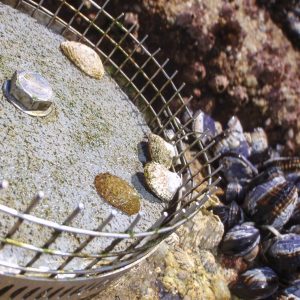
We recently had a new paper come out in Marine Ecology Progress Series, titled Quantifying the top-down effects of grazers on a rocky shore: selective grazing and the potential for competition (open access link at MEPS) (permanent doi link).
This project involved putting a series of round aluminum plates out in the high intertidal zone at Hopkins Marine Station in Pacific Grove, CA, and allowing natural microalgae to settle and grow on the plate surface. We fenced in small limpets on the plates (see image above), which then fed on the microalgae growing on the plates. There were also fenced control plates that did not have limpets on them, as well as plates that had no fence at all, which let neighboring limpets and snails crawl up onto the plates to feed. After a few months, we cut out small squares of the gray rubber grip tape on the surface of the plate, preserved the microalgae on the squares in gluteraldehyde, and took pictures of the algae scuzz growing on the plate surfaces using a scanning electron microscope .
Diana LaScala-Gruenewald then spent months staring at these images, identifying and categorizing the various diatoms, cyanobacteria, encrusting algae, and other junk growing on the plate surface where the limpets had been feeding (pictured below).

In general, we found that limpets tended to first graze off the diatoms and cyanobacteria from the surfaces, perhaps because these were the larger, easier to access components of the scuzz community. They left behind more of the crustose microalgae, maybe because these were harder to reach down in the crevices of the rubber grip tape. Interestingly, the remaining microalgae on the limpet-grazed plates were less nutritious than the full community on the ungrazed plates (based on Carbon:Nitrogen ratio analyses), indicating that the limpets were taking off the more nitrogen-rich microalgae from the plates.
There was also a temperature component to this experiment, since we put out the identical plates at many different sites in the intertidal zone, some more sun-exposed than other, some more wave-exposed. In general, we found that ungrazed algae (no limpets hanging around) were reduced in density on warmer plates. But, once you have grazers on the plates, either the corralled limpets or the neighboring critters on the unfenced plates, the temperature effect on algae density disappeared, since the grazing animals knocked down the microalgae to a low baseline level regardless of the temperature.
There is lots more analysis in the paper, but that’s the short and sweet version.